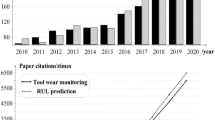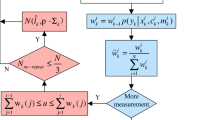Abstract
Accurate cutting tool remaining useful life (RUL) prediction is of significance to guarantee the cutting quality and minimize the production cost. Recently, physics-based and data-driven methods have been widely used in the tool RUL prediction. The physics-based approaches may not accurately describe the time-varying wear process due to a lack of knowledge for underlying physics and simplifications involved in physical models, while the data-driven methods may be easily affected by the quantity and quality of data. To overcome the drawbacks of these two approaches, a hybrid prognostics framework considering tool wear state is developed to achieve an accurate prediction. Firstly, the mapping relationship between the sensor signal and tool wear is established by support vector regression (SVR). Then, the tool wear statuses are recognized by support vector machine (SVM), and the results are put into a Bayesian framework as prior information. Thirdly, based on the constructed Bayesian framework, the tool wear model parameters are updated iteratively by the sliding time window and particle filter algorithm. Finally, the tool wear state space and RUL can be predicted accordingly using the updating tool wear model. The validity of the proposed method is demonstrated by a high-speed machine tool experiment. The results show that the presented approach can effectively reduce the uncertainty of tool wear state estimation and improve the accuracy of RUL prediction.













Similar content being viewed by others
Data availability
Data related to this work will be provided upon request.
Code availability
Part of the code can be provided upon request for noncommercial purpose.
References
Sun H, Liu Y, Pan J, Zhang J, Ji W (2020) Enhancing cutting tool sustainability based on remaining useful life prediction. J Clean Prod 244(118):794. https://doi.org/10.1016/j.jclepro.2019.118794
Kurada S, Bradley C (1997) A review of machine vision sensors for tool condition monitoring. Comput Ind 34(1):55–72. https://doi.org/10.1016/S0166-3615(96)00075-9
Yang Y, Guo Y, Huang Z, Chen N, Li L, Jiang Y, He N (2019) Research on the milling tool wear and life prediction by establishing an integrated predictive model. Measurement 145:178–189. https://doi.org/10.1016/j.measurement.2019.05.009
Liao L, Köttig F (2016) A hybrid framework combining data-driven and model-based methods for system remaining useful life prediction. Appl Soft Comput 44:191–199. https://doi.org/10.1016/j.asoc.2016.03.013
Yen YC, Söhner J, Lilly B, Altan T (2004) Estimation of tool wear in orthogonal cutting using the finite element analysis. J Mater Process Technol 146(1):82–91. https://doi.org/10.1016/S0924-0136(03)00847-1
Kadirgama K, Abou-El-Hossein K, Noor M, Sharma K, Mohammad B (2011) Tool life and wear mechanism when machining Hastelloy C-22HS. Wear 270(3–4):258–268. https://doi.org/10.1016/j.wear.2010.10.067
Hatt O, Crawforth P, Jackson M (2017) On the mechanism of tool crater wear during titanium alloy machining. Wear 374:15–20. https://doi.org/10.1016/j.wear.2016.12.036
Malakizadi A, Shi B, Hoier P, Attia H, Krajnik P (2020) Physics-based approach for predicting dissolution–diffusion tool wear in machining. Cirp Ann-Manuf Techn 69(1):81–84. https://doi.org/10.1016/j.cirp.2020.04.040
Pálmai Z (2013) Proposal for a new theoretical model of the cutting tool’s flank wear. Wear 303(1–2):437–445. https://doi.org/10.1016/j.wear.2013.03.025
Attanasio A, Ceretti E, Rizzuti S, Umbrello D, Micari F (2008) 3D finite element analysis of tool wear in machining. CIRP Ann 57(1):61–64. https://doi.org/10.1016/j.cirp.2008.03.123
Wang J, Wang P, Gao RX (2015) Enhanced particle filter for tool wear prediction. J Manuf Syst 36:35–45. https://doi.org/10.1016/j.jmsy.2015.03.005
Galante G, Lombardo A, Passannanti A (1998) Tool-life modelling as a stochastic process. Int J Mach Tools Manuf 38(10–11):1361–1369. https://doi.org/10.1016/S0890-6955(98)00019-4
Sun H, Pan J, Zhang J, Cao D (2020) Non-linear Wiener process–based cutting tool remaining useful life prediction considering measurement variability. Int J Adv Manuf Technol 107(11):4493–4502. https://doi.org/10.1007/s00170-020-05264-3
Beibei Z, Jing C, Kang C (2016) Residual life prediction for tungsten carbide coatings based on Gamma process. Trans Nanjing Univ Aeronaut Astronaut 48(6):884–889. https://doi.org/10.16356/j.1005-2615.2016.06.016
Huang Y, Lu Z, Dai W, Zhang W, Wang B (2021) Remaining useful life prediction of cutting tools using an inverse Gaussian process model. Appl Sci 11(11):5011. https://doi.org/10.3390/app11115011
Lei Y, Yang B, Jiang X, Jia F, Li N, Nandi AK (2020) Applications of machine learning to machine fault diagnosis: a review and roadmap. Mech Syst Signal Process 138:106,587. j.ymssp.2019.106587
D’Addona DM, Ullah AS, Matarazzo D (2017) Tool-wear prediction and pattern-recognition using artificial neural network and DNA-based computing. J Intell Manuf 28(6):1285–1301. https://doi.org/10.1007/s10845015-1155-0
Twardowski P, Wiciak-Pikuła M (2019) Prediction of tool wear using artificial neural networks during turning of hardened steel. Materials 12(19):3091. https://doi.org/10.3390/ma12193091
Benkedjouh T, Medjaher K, Zerhouni N, Rechak S (2015) Health assessment and life prediction of cutting tools based on support vector regression. J Intell Manuf 26(2):213–223. https://doi.org/10.1007/s10845-013-0774-6
Cheng M, Jiao L, Shi X, Wang X, Yan P, Li Y (2020) An intelligent prediction model of the tool wear based on machine learning in turning high strength steel. P I Mech Eng B-J Eng 234(13):1580–1597. https://doi.org/10.1177/0954405420935787
Li W, Liu T (2019) Time varying and condition adaptive hidden Markov model for tool wear state estimation and remaining useful life prediction in micro-milling. Mech Syst Signal Process 131:689–702. https://doi.org/10.1016/j.ymssp.2019.06.021
Zhu K, Liu T (2017) Online tool wear monitoring via hidden semi-Markov model with dependent durations. IEEE Trans Industr Inform 14(1):69–78. https://doi.org/10.1109/TII.2017.2723943
Xu X, Wang J, Zhong B, Ming W, Chen M (2021) Deep learning-based tool wear prediction and its application for machining process using multi-scale feature fusion and channel attention mechanism. Measurement 177(109):254. https://doi.org/10.1016/j.measurement.2021.109254
An Q, Tao Z, Xu X, El Mansori M, Chen M (2020) A data-driven model for milling tool remaining useful life prediction with convolutional and stacked LSTM network. Measurement 154(107):461. https://doi.org/10.1016/j.measurement.2019.107461
Marani M, Zeinali M, Songmene V, Mechefske CK (2021) Tool wear prediction in high-speed turning of a steel alloy using long short-term memory modelling. Measurement 177(109):329. https://doi.org/10.1016/j.measurement.2021.109329
Li H, Wang W, Li Z, Dong L, Li Q (2020) A novel approach for predicting tool remaining useful life using limited data. Mech Syst Signal Process 143(106):832. https://doi.org/10.1016/j.ymssp.2020.106832
Sun H, Cao D, Zhao Z, Kang X (2018) A hybrid approach to cutting tool remaining useful life prediction based on the Wiener process. IEEE Trans Reliab 67(3):1294–1303. https://doi.org/10.1109/tr.2018.2831256
Wang J, Li Y, Zhao R, Gao RX (2020) Physics guided neural network for machining tool wear prediction. J Manuf Syst 57:298–310. https://doi.org/10.1016/j.jmsy.2020.09.005
Wang P, Gao RX (2015) Adaptive resampling-based particle filtering for tool life prediction. J Manuf Syst 37:528–534. https://doi.org/10.1016/j.jmsy.2015.04.006
Pang CK, Zhou JH, Yan HC (2014) PDF and breakdown time prediction for unobservable wear using enhanced particle filters in precognitive maintenance. IEEE Trans Instrum Meas 64(3):649–659. https://doi.org/10.1109/TIM.2014.2351312
Yang B, Guo K, Liu J, Sun J, Song G, Zhu S, Sun C, Jiang Z (2020) Vibration singularity analysis for milling tool condition monitoring. Int J Mech Sci 166(105):254. https://doi.org/10.1016/j.ijmecsci.2019.105254
Archard J (1953) Contact and rubbing of flat surfaces. J Appl Phys 24(8):981–988. https://doi.org/10.1063/1.1721448
Choudhury S, Srinivas P (2004) Tool wear prediction in turning. J Mater Process Technol 153:276–280. https://doi.org/10.1016/j.jmatprotec.2004.04.296
Cortes C, Vapnik V (1995) Support-vector networks. Mach Learn 20(3):273–297. https://doi.org/10.1007/BF00994018
Colpani A, Fiorentino A, Ceretti E, Attanasio A (2019) Tool wear analysis in micromilling of titanium alloy. Precis Eng 57:83–94. https://doi.org/10.1016/j.precisioneng.2019.03.011
Arulampalam MS, Maskell S, Gordon N, Clapp T (2002) A tutorial on particle filters for online nonlinear/non-Gaussian Bayesian tracking. IEEE Trans Signal Process 50(2):174–188. https://doi.org/10.1109/78.978374
Li T, Bolic M, Djuric PM (2015) Resampling methods for particle filtering: classification, implementation, and strategies. IEEE Signal Process Mag 32(3):70–86. https://doi.org/10.1109/MSP.2014.2330626
Kim HG, Park YH, Cho YH, Kim MH (2014) Time-slide window join over data streams. J Intell Inf Syst 43(2):323–347. https://doi.org/10.1007/s10844-014-0325-4
Li X, Lim B, Zhou J, Huang S, Phua S, Shaw K, Er M (2009) Fuzzy neural network modelling for tool wear estimation in dry milling operation. In: Annual Conference of the PHM Society
Van der Maaten L, Hinton G (2008) Visualizing data using t-SNE. J Mach Learn Res 9(11)
Funding
This work is supported by the National Natural Science Foundation of China (Grant No. 51475425).
Author information
Authors and Affiliations
Contributions
Yifan Li: conceptualization, methodology, software, writing—original draft preparation. Yongyong Xiang: investigation, writing—original draft preparation. Baisong Pan: data curation, software, validation, writing—reviewing and editing. Luojie Shi: resources, supervision.
Corresponding author
Ethics declarations
Ethics approval
The manuscript has only communicated to one journal only and has not submitted to more than one journal for simultaneous consideration.
Consent to participate
The authors have given their consent to participate.
Consent for publication
The authors have given their consent to publish the present paper.
Conflict of interest
The authors declare no competing interests.
Additional information
Publisher's Note
Springer Nature remains neutral with regard to jurisdictional claims in published maps and institutional affiliations.
Rights and permissions
About this article
Cite this article
Li, Y., Xiang, Y., Pan, B. et al. A hybrid remaining useful life prediction method for cutting tool considering the wear state. Int J Adv Manuf Technol 121, 3583–3596 (2022). https://doi.org/10.1007/s00170-022-09417-4
Received:
Accepted:
Published:
Issue Date:
DOI: https://doi.org/10.1007/s00170-022-09417-4




